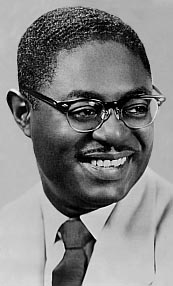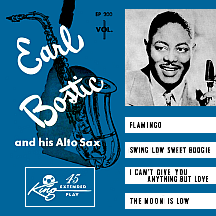EARL BOSTIC
Flamingo
Speaking of versatile musicians who mastered a specific instrument, alto saxophonist Earl Bostic really set the standard. Yet he never imposed limits on himself; the opportunity at age 18 to enroll at Xavier University in New Orleans was not taken lightly. He studied music harmony while honing his skill at several other instruments (trumpet, clarinet, piano and guitar) before graduating in 1934 with a Bachelor of Arts degree in music theory. The learning curve didn't stop there; playing with a dozen or more jazz groups small and large, Earl developed a style that one might call aggressive yet smooth and seamless, leaning into a sax and achieving any sound he sought, a growl or low tremolo effect that clubgoers found exciting. Even on softer tunes, his performances were stimulating with near-perfect execution. It's no surprise he gigged with many of the greatest jazz musicians of the 1930s and '40s...while occasionally relegating certain so-called virtuosos to a secondary position on their own bandstands!
There was never any other focus during Earl's formative years; after his time at Booker T. Washington High School in home town Tulsa, Oklahoma, he briefly played with Terrence Holder's Kansas City-based band Twelve Clouds of Joy before attending Xavier, where he met his future wife (though more than a decade passed before they married). After graduating, Earl logged time with several bands; many musicians sharpened their skills with Fate Marable, a bandleader who famously performed on steamboat cruises between Minnesota and Louisiana. Earl joined him on the river for a time, gaining an entirely different kind of education. Back on dry land in the mid- to late-'30s, he hopped from band to band, working in Columbus, Cleveland and Buffalo. He did musical arrangements for many acts, most prominent among them Paul Whiteman, one of the most successful bandleaders in history, and a young Louis Prima.
Moving to New York in 1938, Bostic put a combo together and performed the following year at popular Harlem night spot Small's Paradise, occasionally setting the alto sax aside to blow trumpet or riff on the guitar. His first recording session took place at RCA Victor's East 24th Street studio on October 12, 1939 with the great vibraphonist and singer Lionel Hampton's eight-piece orchestra. Hampton vocal "The Heebie Jeebies Are Rockin' the Town," one of four sides to feature Earl's sax work, was released on 78 in December; an instrumental number, "Haven't Named it Yet," featuring each musician for a few bars, followed in early 1940. In '41 he performed with Texas-born trumpeter Hot Lips Page at Bill Robinson's Mimo Professional Club in Harlem. Remaining in N.Y. after the U.S. entered World War II, he was a featured musician with several bands including a second stint with Hampton and recording sessions with Page, Buck Ram's All Stars and Rex Stewart.
In 1945 he assembled a solid quintet featuring pianist Ed Finkel, guitarist Tiny Grimes, bassist Al Hall and drummer Cozy Cole. In November, four tracks were recorded with 12 musicians (including his backing quartet): slow-burner "The Man I Love" and his first-time-on-disc vocal performance "Hurricane Blues," in addition to "The Major and the Minor" and "All On," all tight, well-executed productions, though he wasn't exactly paving new ground. These were issued as Earl Bostic and his Orchestra on two Majestic label discs the following summer. A March '46 session yielded another vocal jump tune,"That's the Groovy Thing" (with a smaller outfit achieving the desired "big" sound), which was released on Gotham prior to the Majestic discs, making it essentially the first single under his name made available to the public.
Syd Nathan of Cincinnati-based King Records liked what he heard and signed Bostic to a long-term contract. The first King 78 arrived just before the end of 1947; "845 Stomp" and "Earl's Rumboogie," a couple of wild instrumental E.B. originals (with pianist George Parker, bassist Vernon King and drummer Shep Shepherd, all from earlier Gotham sessions), suggested he was upping the ante with Nathan's approval, though taking the risk of alienating a large segment of his audience by venturing further from the jazz norm. Fortunately a new movement called bebop was coming on strong and he would fit right in. Gotham continued putting out earlier recordings; "Bostic's Jump" backed with "Hot Sauce! - Boss," released right after the King disc, were nearly as unhinged. The next Gotham single became Earl's first chart hit. "Temptation" (a Nacio Herb Brown-Arthur Freed song performed by Bing Crosby in the 1933 film Going Hollywood) had been a major pop/country novelty hit in '47 for Red Ingle and the Natural Seven (under the title "Tim-Taysion") with a corny country vocal by Jo Stafford (billed as "Cinderella G. Stump"). An instrumental jazz version was needed to restore Earth's axis to a level position and Bostic's rhythmic rendition did the trick, reaching Billboard's Race Records top ten in May 1948.
An early '49 single issued on Gotham and King was "Disc Jockey's Nightmare," a frenzied pastiche of standard hits with riff-after-sax-riff lending truth to the title while demonstrating Earl's fluidity with his primary instrument. Nathan was supportive of Bostic, allowing him to indulge any creative impulse; the label was a comfortable home for the sax master for many years. He became a regular on the bebop scene at a number of venues including Minton's Playhouse on West 118th in Harlem, joining Dizzy Gillespie, Thelonious Monk and other stars of the fast-paced, improvisational technique. Legend has it he outplayed Charlie "Byrd" Parker at Minton's one night, beating the bebop star at his own game...a notion at odds with Parker's revered reputation. While critics frequently condemned Bostic's hot, blazing style as "coarse" or "vulgar," there were many who ranked him as one of the best in the biz. Diverging opinions like these can usually be expected when someone comes along who (much like Parker) moves an art form in a direction beyond what came before. Besides, the widely-admired saxophonist John Coltrane, was part of Bostic's band early in his career, later cited him as a major influence...and who would argue with Coltrane?

Bostic scored a top ten R&B hit in the summer of 1951 with "Sleep," written in 1923 by Earl Lebieg (a pen name for Adam Geibel) with lyrics added by Earl Burtnett (the melody was based on Lebieg's "Visions of Sleep" from 1903 and in '24 became the first number one hit for Fred Waring's Pennsylvanians). Bostic's instrumental take increased the original's dreamy pace considerably; the record's success brought further demand for live appearances and he and his band (numbering from five to ten members at various times) enjoyed a fully booked headlining schedule. Before year's end, another song cemented E.B.'s stature; "Flamingo" had been written in 1940 by Romanian Ted Grouya with Manhattan stockbroker-lyricist Edmund Anderson and was a hit in early '41 for Duke Ellington with vocalist Herb Jeffries. There were many versions of the song in the decade between Duke's and Earl's slabs of wax; Bostic took an easier approach with his recording (while still hitting some of the "coarse"-but-amazing notes he was well known for) and reaped the benefits with a number one R&B hit in December 1951 and January '52.
Oddly, there were no more chart hits after "Flamingo." On the other hand, he had more vinyl record releases over the next decade than just about anyone, running the gamut from standards ("Moonglow," "Smoke Gets in Your Eyes," "Deep Purple") to original compositions ("Cracked Ice," "Mambolino," "Up There in Orbit"), plus novelties, foreign tunes and film themes. Bostic recorded roughly 400 instrumental tracks over more than 16 years with the label (there were about 90 singles, more than 30 EPs and 30 more albums). His audience was locked in, sales were limited but consistent and added up nicely due to the sheer bulk of ongoing product. This despite a serious heart attack in 1956 that sidelined him more than two years, although the record releases (drawing from a backlog of recordings) kept coming. Earl got back into the studio and resumed a lighter touring schedule in 1959 (he performed that August at the Playboy Jazz Festival in Chicago) but his output progressed at a noticeably slower pace.
In the early '60s Earl opened the Flying Fox restaurant and nightclub on West Santa Barbara Avenue in Los Angeles and his wife, Hildegard Bostic, managed it for him. By 1965 their 23-year marriage was strained; he became anxious to go back to New York because of a widespread belief at the time that earthquakes would cause California to fall into the ocean. The couple, who lived in a 75,000 dollar home in Baldwin Hills, were separated in February; he went on the road with his band and bought a modest place in Detroit as his new "home base." She had no intention of leaving (for one thing, the Flying Fox was a successful enterprise) and filed for divorce. No more than a couple of weeks passed when, on October 26, Earl suffered a heart attack after performing with his trio on their opening night at the Midtown Tower Hotel in Rochester, New York; he was hospitalized and died two days later. Hildegard had his body flown back to L.A. and the funeral was held several days later at Mt. Sinai Baptist Church.
Less than a month after Earl's death, Hildegard put both the Baldwin Hills house and the Flying Fox up for sale. A relationship she'd been having with former dancer Al Williams was made public (his act The Four Step Brothers, formed in 1925, had performed thrilling dance routines in Harlem, toured throughout the U.S., were featured in several movies and made appearances on television during the '50s before breaking up around 1960); at the time, Williams was working in artist management. Hidegarde's plans were to move somewhere back east, but she didn't say where. Journalists began buzzing about impending nuptials...that never occurred. At just 52 years of age, prolific musician Earl Bostic had departed far too soon. Music fans may have a "friend" or "foe" attitude where he's concerned, depending on their personal music preferences. But his level of talent can't be questioned and hundreds of recordings exist to prove his worth.


